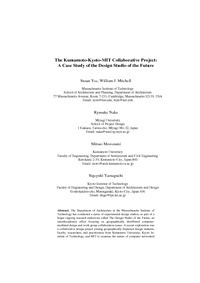The Kumamoto-Kyoto-MIT Collaborative ProjectA Case Study of the Design Studio of the Future
Susan Yee, William J. Mitchell, Ryusuke Naka, Mitsuo Morozumi, Sigeyuki Yamaguchi
Publikationsdatum:
Zu finden in: Cooperative Buildings: Integrating Information, Organization, and Architecture (Seite 80 bis 93), 1998
|
 |
 Diese Seite wurde seit 5 Jahren inhaltlich nicht mehr aktualisiert.
Unter Umständen ist sie nicht mehr aktuell.
Diese Seite wurde seit 5 Jahren inhaltlich nicht mehr aktualisiert.
Unter Umständen ist sie nicht mehr aktuell.
 Zusammenfassungen
Zusammenfassungen
The Department of Architecture at the Massachusetts Institute of Technology has conducted a series of experimental design
studios, as part of a larger ongoing research endeavour called The Design Studio of the Future, an interdisciplinary effort
focusing on geographically distributed computer-mediated design and work group collaboration issues. A recent exploration
was a collaborative design project joining geographically dispersed design students, faculty, researchers, and practitioners
from Kumamoto University, Kyoto Institute of Technology, and MIT to examine the nature of computer networked collaborative
environments and advanced computer-aided design technologies to support architectural education and practice. This paper will
describe this project, which provided the students and faculty members with practical experience in the use of emerging technologies
for collaboration, design, and communication in both the day-to-day activities of distributed groupwork as well as in the
more formalized reviews.
Von Susan Yee, William J. Mitchell, Ryusuke Naka, Mitsuo Morozumi, Sigeyuki Yamaguchi im Konferenz-Band Cooperative Buildings: Integrating Information, Organization, and Architecture im Text The Kumamoto-Kyoto-MIT Collaborative Project (1998)  Dieses Konferenz-Paper erwähnt ...
Dieses Konferenz-Paper erwähnt ...
 Volltext dieses Dokuments
Volltext dieses Dokuments
 |  The Kumamoto-Kyoto-MIT Collaborative Project: Artikel als Volltext bei Springerlink ( The Kumamoto-Kyoto-MIT Collaborative Project: Artikel als Volltext bei Springerlink ( : :  , 617 kByte; , 617 kByte;  : :  Link unterbrochen? Letzte Überprüfung: 2021-03-21 Letzte erfolgreiche Überprüfung: 2019-10-11) Link unterbrochen? Letzte Überprüfung: 2021-03-21 Letzte erfolgreiche Überprüfung: 2019-10-11) |
 Anderswo suchen
Anderswo suchen 
 Beat und dieses Konferenz-Paper
Beat und dieses Konferenz-Paper
Beat hat Dieses Konferenz-Paper während seiner Zeit am Institut für Medien und Schule (IMS) ins Biblionetz aufgenommen. Beat besitzt kein physisches, aber ein digitales Exemplar. Eine digitale Version ist auf dem Internet verfügbar (s.o.). Aufgrund der wenigen Einträge im Biblionetz scheint er es nicht wirklich gelesen zu haben. Es gibt bisher auch nur wenige Objekte im Biblionetz, die dieses Werk zitieren.










 Biblionetz-History
Biblionetz-History